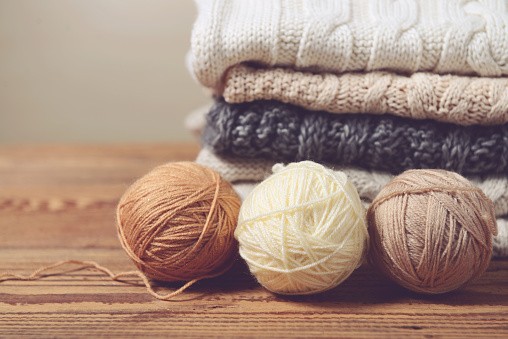
Subscribe To Emails
Subscribe to the YourCotton mailing list to receive updates on new arrivals and promotions (about once every 6 weeks)!

Whether you’re searching for the perfect addition to your wardrobe or looking to spruce up an existing outfit, flannel is a timeless option that always comes out on top. But before you invest in a flannel shirt, it’s important to understand the material and what care it requires.
In this article, we’ll answer, “does flannel fray?” - read on to learn more about the nature of this cozy and versatile fabric!

Flannel is a sewing pattern that is often mistaken for fabric. It's understandable why - with plaid shirts made commonly out of flannel, it's easy to see why the sewing pattern used to make them and the fabric itself are seen as interchangeable. But in truth, flannel sew patterns apply to many types of fabrics.
This sewing pattern can be traced back centuries to Wales, where it was known as 'Gwlanan.' Often used to make workwear and undergarments back then due to its warmth, durability, and inexpensive nature, flannel nowadays is more likely found in bedding or ultra-cozy loungewear.
In years past, sewers crafted quilts and blankets from flannel composed of carded wool or worsted yarns for a cozy feel. Today, any fiber can be used to make these items giving crafters free range in their creations.
Cotton is an especially popular option because it’s similar to wool but does not insulate heat as effectively. Additionally, the fabric’s loosely spun yarns provide most of the softness sewers want in a flannel quilt product. This loosely woven fabric is then often napped or brushed to get an even softer surface, with spaces between the fibers creating tiny air pockets to trap warmth while remaining breathable.
Flannel comes in a variety of types, including wool, cotton, blended, ceylon, diaper, and vegetable flannel plus flannelette, making it useful for many different projects like pajamas, diapers, quilts, and more.
Why Flannel Won't Fray
Here are some of the reasons why flannel doesn't fray:
Made With Woven Fabric
Flannel is a fabric often used to make warm and comfortable clothing, such as flannel shirts. When making flannel shirts, the fabric must be carefully sewn with a zig-zag stitch. Before you start, it's important to understand that flannel is made with interwoven threads, meaning that the threads are criss-crossed in a manner that prevents them from unraveling.
When sewing flannel fabric, it's best to use a sewing machine designed for heavier fabrics. As always, when working with any type of clothing fabric, you should take your time and use extra care to guarantee the end product will be something you can happily wear for years to come.
Shorter Fibers
Flannel is a soft fabric renowned for being warm and comfortable. It's a looser weave of shorter fibers, making it less prone to fraying, ensuring it continues to be in great condition, even after multiple washes.
When sewing with flannel, you must reduce the stitch length as the looser weave may cause regular stitches to be too long and may give the project an uneven finish. Homemaking projects such as blankets, quilts, and pillowcases can only benefit from using this fabric, so why not give them a go?
Made With Natural Fibers Like Cotton Or Wool
Flannel is a special type of fabric used for generations to sew items like blankets and shirts. It is often made from natural fibers such as cotton or wool, which allow for better sew-ability than synthetic fibers.
Flannel can be in a plain or twill weave, and typically featuring a soft, fuzzy texture due to the loose weave employed. Many people use flannel to sew quilts, as it is lightweight and trapped air keeps you warm during colder weather. With the warmth and durability of flannel material, it's no wonder this fabric has stood the test of time!
Often Brushed Or Napped
Flannel is a great fabric choice for a variety of garments. It is durable and doesn't easily show wear or tear, but you can also soften it for comfort. Napping and brushing processes add an extra layer of protection to flannel fabrics, making them even more resilient against fraying.
Not only does napping prevent unraveling at the seams, but it also keeps its shape better during cleaning and wears well over time. Brushing flannel helps individual fibers lie flat and smooth on the surface so they remain in place rather than becoming weak over time. Thanks to these extra processes, you can enjoy the warmth and texture of flannel without worrying about it unraveling or becoming worn out down the line!
Treated With A Finish
Flannel is a cozy, soft fabric that’s popular in cold-weather clothing because of its insulation properties. It's important to note, however, that not just any flannel will do when it comes to this purpose — it must be treated with a finish that helps to seal the fibers and prevent fraying. This way, the garment remains snug and comfortable for many seasons to come despite frequent use.
The finish typically used on flannel is waterproofing and anti-static coating — an ideal combination for outdoor activities. So when shopping for flannel pieces, be sure to look for garments that are specifically designed for protection against the elements. In this way, you can ensure maximum comfort, no matter the weather conditions!
Flannel may not be the most glamorous fabric, but it more than makes up for that in its durability. This sturdy material can withstand a lot of wear and tear, making it ideal for clothing that gets a lot of use, like shirts and pants. And since it doesn't fray easily, you don't have to worry about your clothes looking worn down after a few washes. So next time you're looking for something that will last, reach for flannel--you won't be disappointed.
When it’s time for your next project, search through YourCotton’s wide range of different flannel designs to help add style, class, and quality to your creation.